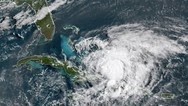Marylanders Urged to Monitor Hurricane Isaias, Which Could Impact Maryland Early Next Week
| Now is the Time to Update Supply Kit, Include COVID-19 in Plans, and Know Your Zone |  |
REISTERSTOWN, Md. (July 31, 2020) —The Maryland Emergency Management Agency (MEMA) encourages all Marylanders to monitor Hurricane Isaias and make plans now in case the storm impacts the Mid-Atlantic region. Forecasters remain uncertain about the exact track of the storm, but some models show it will affect parts of Maryland as soon as Monday evening of next week as it moves northward.The range of hazards that could affect Maryland is still broad – ranging from little impact, to Isaias bringing flooding rains and tropical storm force winds to central and eastern Md.
“Now is the time to make sure you are ready for possible effects from Hurricane Isaias,” said Russ Strickland, MEMA’s Executive Director. “The COVID-19 pandemic adds another layer of complexity during a tropical storm or hurricane, and that means there may be changes to normal evacuation and sheltering plans,” he added.
MEMA also reminds Maryland residents to make sure emergency kits include at least 2 face coverings for each person, hand sanitizer, disinfectants, and other COVID-19 related supplies in addition to the usual disaster supply kit components.
During the COVID-19 pandemic it’s more important than ever to pay attention to the hazards of hurricane season. As a Marylander or as a visitor to Maryland, you should Know Your Zone to see if the places you live, work, or visit are in one of Maryland’s three evacuation zones. The Know Your Zone program allows local emergency officials to order evacuations by letter zones (A, B and C). To learn more about Know Your Zone or to see if you might be in an evacuation zone, please click here.
Remember that even if you are not in one of the Maryland evacuation zones, you could still feel the effects of hurricanes and other hazards. Hurricanes can spawn flash floods, severe thunderstorms, and tornadoes many miles away form the eye of the storm and 100 miles or more inland.
Here are some additional considerations while planning for hurricanes and other hazards during the COVID-19 pandemic:
- If you must evacuate, bring items such as hand sanitizer, cleaning materials, and two cloth face coverings per person. Children under 2 years old, people who have trouble breathing, and people who cannot take the cloth face covering off without help should not wear cloth face coverings.
- Pay attention to emergency information and alerts from official sources.
- Determine your best protection for high winds and flooding.
- Keep in mind that your best protection from the effects of a hurricane may differ from your best protection from disease.
- Unless you live in an evacuation zone, make a plan to shelter-in-place in your home, if it is safe to do so.
- Check with local authorities for the latest information about public evacuation shelters.
- Only use generators outdoors and never in a garage. The generator should be at least 20 feet away from your home and away from windows, doors, and vents.
- Do not walk, swim, or drive through flood waters.
It is also important to allow extra time to evacuate because shelters might be farther away. As always, residents are better off locating shelter with family or friends outside the expected danger zone or staying at an accommodation of their choice. But state, local, and nonprofit partners will still provide shelter options.
For more information about hurricane preparedness, please visit MEMA, FEMA, the National Weather Service and the American Red Cross.
To receive alerts, tips, and resources related to COVID-19 and other threats and hazards affecting or that may affect Maryland during this hurricane season and beyond, text “MdReady” to 898211.
###
CONTACT:
Maryland State Emergency Operations Center PIO: pio.mema@maryland.gov
